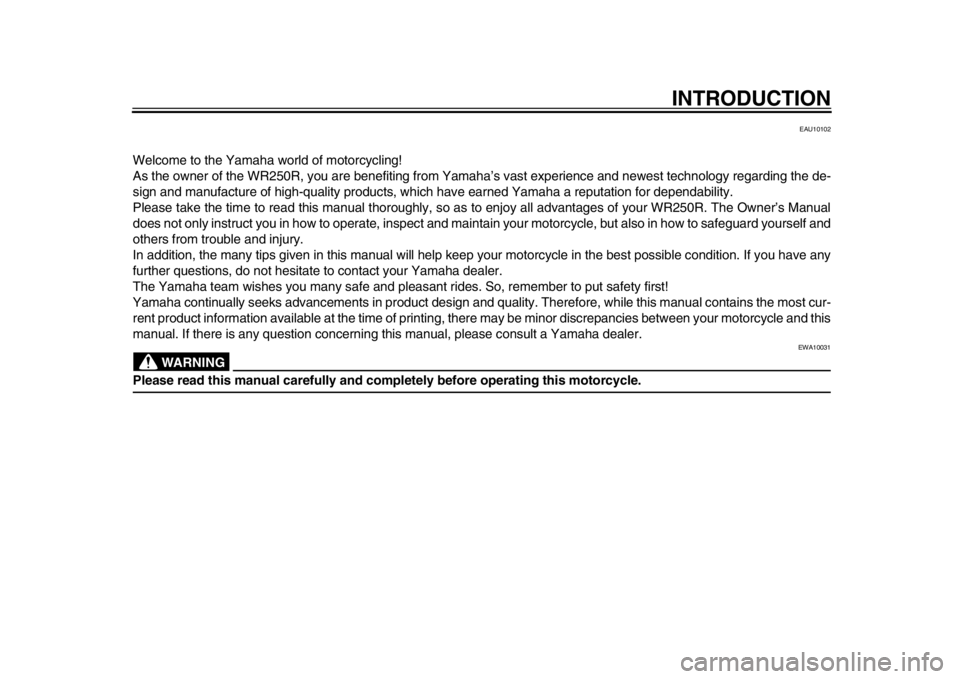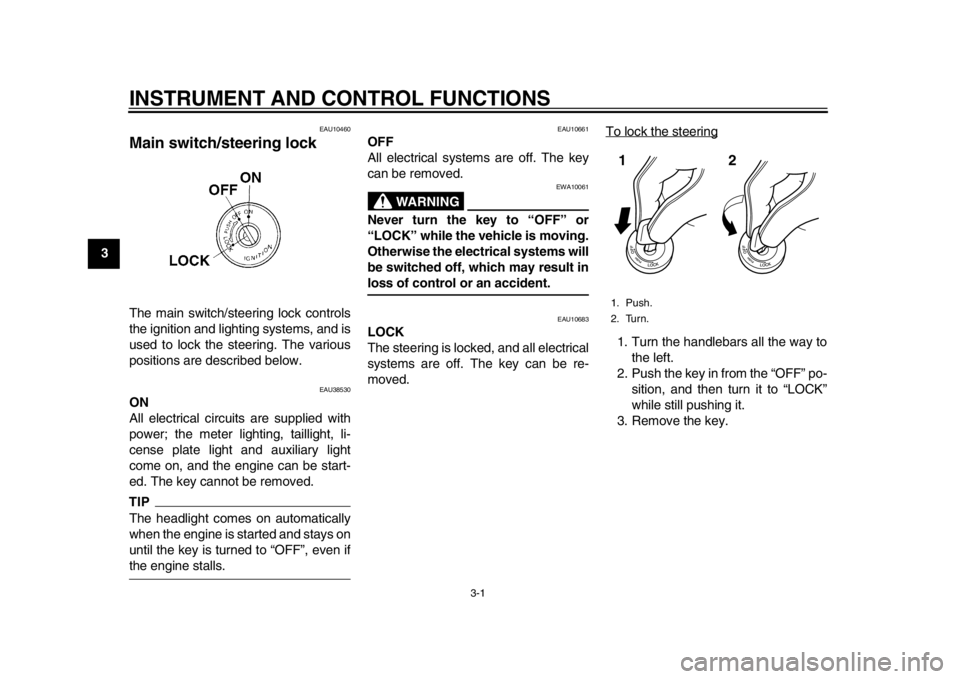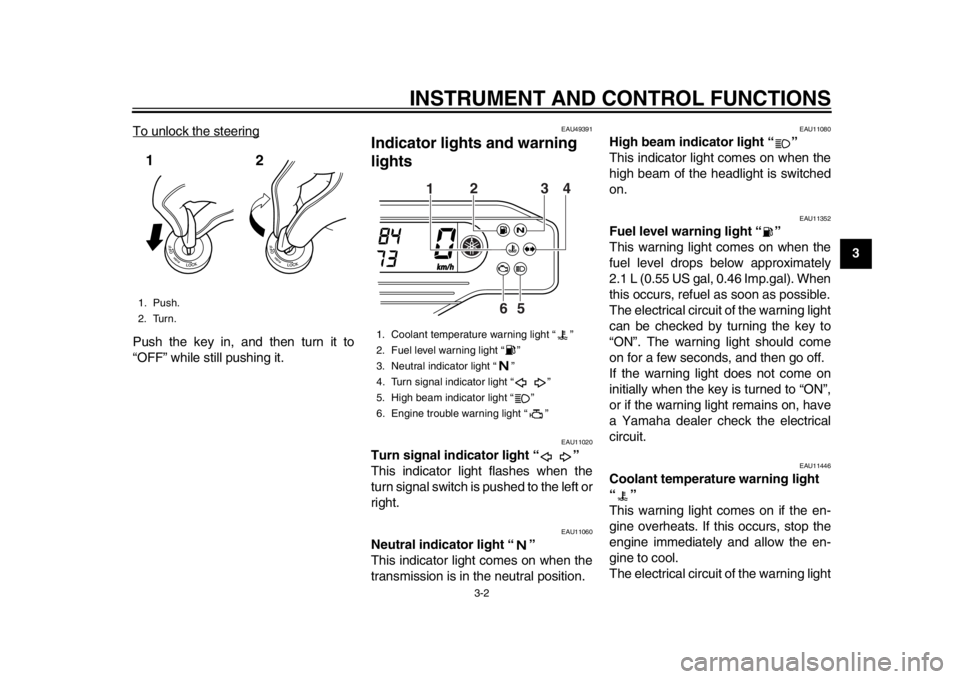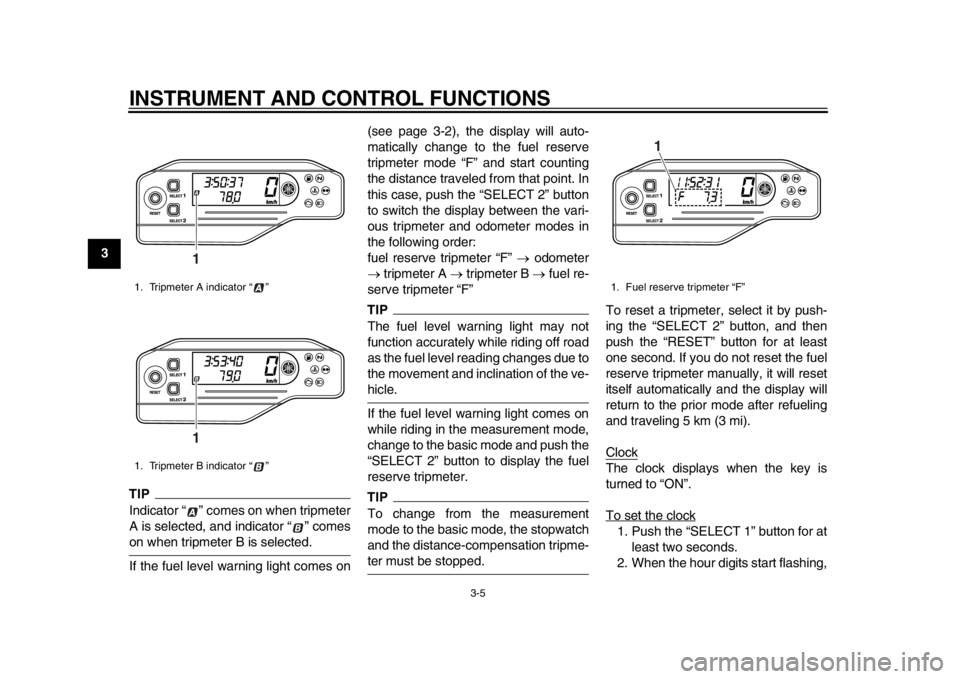warning YAMAHA WR 250R 2012 Owners Manual
[x] Cancel search | Manufacturer: YAMAHA, Model Year: 2012, Model line: WR 250R, Model: YAMAHA WR 250R 2012Pages: 98, PDF Size: 2.57 MB
Page 3 of 98

INTRODUCTION
EAU10102
Welcome to the Yamaha world of motorcycling!
As the owner of the WR250R, you are benefiting from Yamaha’s vast experience and newest technology regarding the de-
sign and manufacture of high-quality products, which have earned Yamaha a reputation for dependability.
Please take the time to read this manual thoroughly, so as to enjoy all advantages of your WR250R. The Owner’s Manual
does not only instruct you in how to operate, inspect and maintain your motorcycle, but also in how to safeguard yourself and
others from trouble and injury.
In addition, the many tips given in this manual will help keep your motorcycle in the best possible condition. If you have any
further questions, do not hesitate to contact your Yamaha dealer.
The Yamaha team wishes you many safe and pleasant rides. So, remember to put safety first!
Yamaha continually seeks advancements in pr oduct design and quality. Therefore, while this manual contains the most cur-
rent product information available at the time of printing, there may be minor discrepancies between your motorcycle and this
manual. If there is any question concerning this manual, please consult a Yamaha dealer.
WARNING
EWA10031
Please read this manual carefully and completely before operating this motorcycle.
32D-9-E8.book 1 ページ 2011年6月28日 火曜日 午前10時27分
Page 4 of 98

IMPORTANT MANUAL INFORMATION
EAU10132
Particularly important information is distinguished in this manual by the following notations:
This is the safety alert symbol. It is used to alert you to potential personal injury
hazards. Obey all safety messages that follow this symbol to avoid possible injury
or death.
A WARNING indicates a hazardous situation wh ich, if not avoided, could result in
death or serious injury.
A NOTICE indicates special precautions that must be taken to avoid damage to the
vehicle or other property.
A TIP provides key information to make procedures easier or clearer.
WARNING
NOTICETIP
32D-9-E8.book 1 ページ 2011年6月28日 火曜日 午前10時27分
Page 6 of 98

TABLE OF CONTENTSSAFETY INFORMATION .................. 1-1
DESCRIPTION .................................. 2-1
Left view .......................................... 2-1
Right view ........................................ 2-2
Controls and instrument s................. 2-3
INSTRUMENT AND CONTROL
FUNCTIONS ....................................... 3-1
Main switch/steering lock ................ 3-1
Indicator lights and warning
lights ............................................ 3-2
Multi-function display ...................... 3-3
Handlebar switches ........................ 3-8
Clutch lever ..................................... 3-9
Shift pedal ...... ............................. .. 3-10
Brake lever ................................... 3-10
Brake pedal .................................. 3-10
Fuel tank cap ................................ 3-11
Fuel ............................................... 3-11
Catalytic converter ........................ 3-13
Seat .............................................. 3-13
Helmet holder ............................... 3-14
Adjusting the front fork .................. 3-14
Front fork bleeding ........................ 3-16
Adjusting the shock absorber assembly ................................... 3-17
EXUP system ............................... 3-18
Sidestand ...................................... 3-19
Ignition circuit cut-off system ........ 3-19 FOR YOUR SAFETY
–
PRE-OPERATION CHECKS ............. 4-1
OPERATION AND IMPORTANT
RIDING POINTS ................................. 5-1
Starting the engine ......................... 5-1
Shifting ........................................... 5-2
Tips for reducing fuel consumption ............................... 5-3
Engine break-in .............................. 5-3
Parking ........................................... 5-4
PERIODIC MAINTENANCE AND
ADJUSTMENT ................................... 6-1
Owner’s tool kit ............................... 6-2
Periodic maintenance chart for the emission contro l system ....... 6-3
General maintenance and lubrication chart .......................... 6-4
Removing and installing panels ..... 6-8
Checking the spark plug ............... 6-11
Engine oil and oil filter element .... 6-12
Coolant ......................................... 6-14
Cleaning the air filter element and check hose ......................... 6-17
Adjusting the engine idling speed ........................................ 6-19
Checking the throttle grip free
play ........................................... 6-19
Valve clearance ............................ 6-20
Tires ............................................. 6-20 Spoke wheels ............................... 6-22
Adjusting the clutch lever free
play ............................................ 6-22
Adjusting the brake lever free play ............................................ 6-23
Checking the shift pedal ............... 6-24
Brake light switches ...................... 6-24
Checking the front and rear brake pads ................................. 6-25
Checking the brake fluid level ....... 6-25
Changing the brake fluid ............... 6-26
Drive chain slack ........................... 6-27
Cleaning and lubricating the drive chain ................................. 6-28
Checking and lubricating the cables ........................................ 6-29
Checking and lubricating the
throttle grip and cable ................ 6-29
Checking and lubricating the brake and clutch levers ............. 6-29
Checking and lubricating the brake pedal ................................ 6-30
Checking and lubricating the
sidestand ................................... 6-30
Lubricating the swingarm
pivots ......................................... 6-31
Checking the front fork .................. 6-31
Checking the steering ................... 6-32
Checking the wheel bearings ........ 6-32
Battery .......................................... 6-32
Replacing the fuses ...................... 6-3432D-9-E8.book 1 ページ 2011年6月28日 火曜日 午前10時27分
Page 8 of 98

1-1
1
SAFETY INFORMATION
EAU1031A
Be a Responsible Owner
As the vehicle’s owner, you are respon-
sible for the safe and proper operation
of your motorcycle.
Motorcycles are single-track vehicles.
Their safe use and operation are de-
pendent upon the use of proper riding
techniques as well as the expertise of
the operator. Every operator should
know the following requirements before
riding this motorcycle.
He or she should:
Obtain thorough instructions from
a competent source on all aspects
of motorcycle operation.
Observe the warnings and mainte-
nance requirements in this Own-
er’s Manual.
Obtain qualified training in safe
and proper riding techniques.
Obtain professional technical ser-
vice as indicated in this Owner’s
Manual and/or when made neces-
sary by mechanical conditions.Safe Riding
Perform the pre-operation checks each
time you use the vehicle to make sure it
is in safe operating condition. Failure to
inspect or maintain the vehicle properly
increases the possibility of an accident
or equipment damage. See page 4-1
for a list of pre-operation checks.
This motorcycle is designed to car-
ry the operator and a passenger.
The failure of motorists to detect
and recognize motorcycles in traf-
fic is the predominating cause of
automobile/motorcycle accidents.
Many accidents have been caused
by an automobile driver who did
not see the motorcycle. Making
yourself conspicuous appears to
be very effective in reducing the
chance of this type of accident.
Therefore:
•
Wear a brightly colored jacket.
• Use extra caution when you are
approaching and passing
through intersections, since in-
tersections are the most likely
places for motorcycle accidents
to occur.
• Ride where other motorists can see you. Avoid riding in another
motorist’s blind spot.
Many accidents involve inexperi-
enced operators. In fact, many op-
erators who have been involved in
accidents do not even have a cur-
rent motorcycle license.
•
Make sure that you are qualified
and that you only lend your mo-
torcycle to other qualified opera-
tors.
• Know your skills and limits.
Staying within your limits may
help you to avoid an accident.
• We recommend that you prac-
tice riding your motorcycle
where there is no traffic until you
have become thoroughly famil-
iar with the motorcycle and all of
its controls.
Many accidents have been caused
by error of the motorcycle opera-
tor. A typical error made by the op-
erator is veering wide on a turn
due to excessive speed or under-
cornering (insufficient lean angle
for the speed).
•Always obey the speed limit and
never travel faster than warrant-
32D-9-E8.book 1 ページ 2011年6月28日 火曜日 午前10時27分
Page 16 of 98

3-1
1
23
4
5
6
7
8
9
INSTRUMENT AND CONTROL FUNCTIONS
EAU10460
Main switch/steering lock The main switch/steering lock controls
the ignition and lighting systems, and is
used to lock the steering. The various
positions are described below.
EAU38530
ON
All electrical circuits are supplied with
power; the meter lighting, taillight, li-
cense plate light and auxiliary light
come on, and the engine can be start-
ed. The key cannot be removed.TIPThe headlight comes on automatically
when the engine is started and stays on
until the key is turned to “OFF”, even ifthe engine stalls.
EAU10661
OFF
All electrical systems are off. The key
can be removed.
WARNING
EWA10061
Never turn the key to “OFF” or
“LOCK” while the vehicle is moving.
Otherwise the electrical systems will
be switched off, which may result inloss of control or an accident.
EAU10683
LOCK
The steering is locked, and all electrical
systems are off. The key can be re-
moved. To lock the steering
1. Turn the handlebars all the way to
the left.
2. Push the key in from the “OFF” po- sition, and then turn it to “LOCK”
while still pushing it.
3. Remove the key.1. Push.
2. Turn.12
32D-9-E8.book 1 ページ 2011年6月28日 火曜日 午前10時27分
Page 17 of 98

INSTRUMENT AND CONTROL FUNCTIONS
3-2
234
5
6
7
8
9
To unlock the steering
Push the key in, and then turn it to
“OFF” while still pushing it.
EAU49391
Indicator lights and warning
lights
EAU11020
Turn signal indicator light “ ”
This indicator light flashes when the
turn signal switch is pushed to the left or
right.
EAU11060
Neutral indicator light “ ”
This indicator light comes on when the
transmission is in the neutral position.
EAU11080
High beam indicator light “ ”
This indicator light comes on when the
high beam of the headlight is switched
on.
EAU11352
Fuel level warning light “ ”
This warning light comes on when the
fuel level drops below approximately
2.1 L (0.55 US gal, 0.46 Imp.gal). When
this occurs, refuel as soon as possible.
The electrical circuit of the warning light
can be checked by turning the key to
“ON”. The warning light should come
on for a few seconds, and then go off.
If the warning light does not come on
initially when the key is turned to “ON”,
or if the warning light remains on, have
a Yamaha dealer check the electrical
circuit.
EAU11446
Coolant temperature warning light
“”
This warning light comes on if the en-
gine overheats. If this occurs, stop the
engine immediately and allow the en-
gine to cool.
The electrical circuit of the warning light
1. Push.
2. Turn.12
1. Coolant temperature warning light “ ”
2. Fuel level warning light “ ”
3. Neutral indicator light “ ”
4. Turn signal indicator light “ ”
5. High beam indicator light “ ”
6. Engine trouble warning light “ ”
1
234
56
32D-9-E8.book 2 ページ 2011年6月28日 火曜日 午前10時27分
Page 18 of 98

INSTRUMENT AND CONTROL FUNCTIONS
3-3
1
23
4
5
6
7
8
9can be checked by turning the key to
“ON”. The warning light should come
on for a few seconds, and then go off.
If the warning light does not come on
initially when the key is turned to “ON”,
or if the warning light remains on, have
a Yamaha dealer check the electrical
circuit.
NOTICE
ECA10021
Do not continue to operate the en-gine if it is overheating.TIP
For radiator-fan-equipped vehi-
cles, the radiator fan(s) automati-
cally switch on or off according to
the coolant temperature in the ra-
diator.
If the engine overheats, see page6-44 for further instructions.
EAU11534
Engine trouble warning light “ ”
This warning light comes on or flashes
if a problem is detected in the electrical
circuit monitoring the engine. If this oc-
curs, have a Yamaha dealer check the
self-diagnosis system. (See page 3-8 for an explanation of the self-diagnosis
device.)
The electrical circuit of the warning light
can be checked by turning the key to
“ON”. The warning light should come
on for a few seconds, and then go off.
If the warning light does not come on
initially when the key is turned to “ON”,
or if the warning light remains on, have
a Yamaha dealer check the electrical
circuit.
EAU45276
Multi-function display
WARNING
EWA12312
Be sure to stop the vehicle before
making any setting changes to the
multi-function display. Changing
settings while riding can distract the
operator and increase the risk of anaccident.1. “RESET” button
2. “SELECT 1” button
3. “SELECT 2” button
4. Clock/stopwatch
5. Speedometer
6. Odometer/tripmeter/fuel reserve tripmeter
1
23
4
5
6
32D-9-E8.book 3 ページ 2011年6月28日 火曜日 午前10時27分
Page 19 of 98

INSTRUMENT AND CONTROL FUNCTIONS
3-4
234
5
6
7
8
9
TIP
The multi-function display can be
set to the basic mode or the mea-
surement mode.
Tripmeter A will automatically re-
set to zero when changing from
the basic mode to the measure-ment mode or vice versa.
Basic mode:
a speedometer
an odometer
two tripmeters (which show the
distance traveled since they were last set to zero)
a fuel reserve tripmeter (which
shows the distance traveled since
the fuel level warning light came
on)
a clock
a self-diagnosis device
Measurement mode:
a speedometer
a distance-compensation tripme-
ter (which shows the accumulated
distance traveled since set to zero
and which can be calibrated to pro-
vide a more accurate tripmeter
reading)
a stopwatch (which shows the time
that has been accumulated since
the start of stopwatch measure-
ment)
a self-diagnosis device
TIP
Be sure to turn the key to “ON” be-
fore using the “SELECT 1”, “SE-
LECT 2” and “RESET” buttons.
When the key is turned to “ON”, all
of the display segments of the
multi-function display will appear and then disappear, in order to test
the electrical circuit.
For the U.K. only: To switch the
speedometer and odometer/trip-
meter displays between kilometers
and miles, press the “SELECT 2”
button until the display changes af-ter the key is turned to “ON”.
Basic mode
Odometer and tripmeter modes
Push the “SELECT 2” button to switch
the display between the odometer
mode and the tripmeter modes A and B
in the following order:
odometer tripmeter A tripmeter B
odometer
1. Stopwatch indicator “ ”
2. Tripmeter A indicator “ ”/Distance-com-
pensation tripmeter “ ”
3. Tripmeter B indicator “ ”
1
3
2
32D-9-E8.book 4 ページ 2011年6月28日 火曜日 午前10時27分
Page 20 of 98

INSTRUMENT AND CONTROL FUNCTIONS
3-5
1
23
4
5
6
7
8
9
TIPIndicator “ ” comes on when tripmeter
A is selected, and indicator “ ” comeson when tripmeter B is selected.
If the fuel level warning light comes on(see page 3-2), the display will auto-
matically change to the fuel reserve
tripmeter mode “F” and start counting
the distance traveled from that point. In
this case, push the “SELECT 2” button
to switch the display between the vari-
ous tripmeter and odometer modes in
the following order:
fuel reserve tripmeter “F”
odometer
tripmeter A tripmeter B fuel re-
serve tripmeter “F”
TIPThe fuel level warning light may not
function accurately while riding off road
as the fuel level reading changes due to
the movement and inclination of the ve-hicle.
If the fuel level warning light comes on
while riding in the measurement mode,
change to the basic mode and push the
“SELECT 2” button to display the fuel
reserve tripmeter.TIPTo change from the measurement
mode to the basic mode, the stopwatch
and the distance-compensation tripme-ter must be stopped. To reset a tripmeter, select it by push-
ing the “SELECT 2” button, and then
push the “RESET” button for at least
one second. If you do not reset the fuel
reserve tripmeter manually, it will reset
itself automatically and the display will
return to the prior mode after refueling
and traveling 5 km (3 mi).
Clock
The clock displays when the key is
turned to “ON”.
To set the clock1. Push the “SELECT 1” button for at
least two seconds.
2. When the hour digits start flashing,
1. Tripmeter A indicator “ ”
1. Tripmeter B indicator “ ”
11
1. Fuel reserve tripmeter “F”
1
32D-9-E8.book 5 ページ 2011年6月28日 火曜日 午前10時27分
Page 23 of 98

INSTRUMENT AND CONTROL FUNCTIONS
3-8
234
5
6
7
8
9
2. Reset the distance-compensation
tripmeter to zero by pushing the
“RESET” button for at least two
seconds.
Resetting the distance-compensation
tripmeter in combination with the stop-watch1. Stop the stopwatch.
2. Reset the distance-compensation tripmeter and the stopwatch to
zero by pushing the “RESET” but-
ton for at least two seconds.
Self-diagnosis device
This model is equipped with a self-diag-
nosis device for vari ous electrical cir-
cuits.
If a problem is detected in any of those
circuits, the engine trouble warning light
will come on and the display will indi-
cate an error code.
If the display indicates any error codes,
note the code number, and then have a
Yamaha dealer check the vehicle.
NOTICE
ECA11590
If the display indicates an error
code, the vehicle should be checked
as soon as possible in order to avoidengine damage.
EAU12348
Handlebar switches Left
Right
1. Error code display
1
1. Dimmer switch “ / ”
2. Turn signal switch “ / ”
3. Horn switch “ ”
1. Engine stop switch “ / ”
2. Start switch “ ”
1
2
31
2
32D-9-E8.book 8 ページ 2011年6月28日 火曜日 午前10時27分